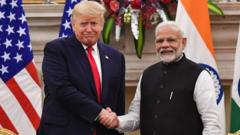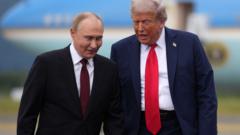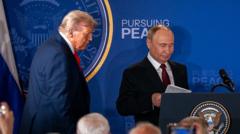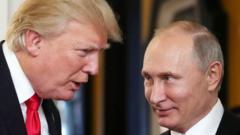As the negotiation window narrows, key points of contention threaten the anticipated interim trade pact between India and the United States, leaving prospects for a deal looking increasingly precarious.
Uncertainty Looms Over India-US Trade Deal as Negotiations Intensify**

Uncertainty Looms Over India-US Trade Deal as Negotiations Intensify**
With a July deadline approaching, trade discussions between India and the US are fraught with challenges, particularly concerning agriculture and tariffs.
In a period of heightened anticipation, the India-US trade agreement appears to be facing substantial difficulties as the July 9 deadline approaches, raising questions about the feasibility of an interim deal. Despite optimistic comments from both US President Donald Trump and Indian Finance Minister Nirmala Sitharaman, crucial negotiations remain tangled in complex discussions.
Key issues persist in the talks, including agricultural market access, tariffs on Indian steel, and automotive components. Negotiators are pushing beyond their original timelines for talks in Washington, as they encounter what Indian officials call "very big red lines" regarding agricultural protections, which the US seeks to challenge in order to secure broader market openings.
The next few days are critical, according to trade analysts, who speculate that the outcome may determine whether the two nations can reach a limited "mini-deal" or if they will have to suspend discussions temporarily. Agriculture sits at the heart of these debates, with US officials advocating for greater access to India's vast farming market—a place India has diligently defended due to food security and the livelihoods of its farmers.
Experts point out that without satisfactory arrangements concerning agricultural products, the negotiation may become untenable. Concerns also revolve around India's non-tariff barriers, specifically its quality control standards that some view as significant impediments to US goods entering the Indian market.
According to analysts, concessions could compel India to reconsider its crucial farm policy safeguards, including minimum support prices (MSP) that protect farmers from price volatility. Contentions remain high over tariff cuts, with particular sensitivity surrounding the agricultural sectors that employ millions of rural Indians.
A report from a government think tank suggested potentially favorable terms regarding tariffs on US agricultural imports, though the authenticity of this proposal remains uncertain. The likelihood of reaching consensus hinges on how both countries balance agricultural access with domestic interests.
Should a limited pact emerge, it may echo components of recent US trade agreements, focusing on industrial goods and select agricultural items. Discussions are likely to shift beyond tariffs, delving into larger commercial commitments and foreign direct investment facilitation in retail sectors.
The initial framework established in early talks aimed for complementary trade goals, yet the evolving landscape indicates that negotiations have indeed shifted gears. As the deadline looms, the specter of failure casts a shadow over the talks; however, experts doubt that the US would impose punitive tariffs typical of trade disputes, citing potential political repercussions.
The coming days will reveal if the trade discussions will culminate in a successful agreement or if both nations will need to seek alternative approaches to their long-standing trade relationship.
Key issues persist in the talks, including agricultural market access, tariffs on Indian steel, and automotive components. Negotiators are pushing beyond their original timelines for talks in Washington, as they encounter what Indian officials call "very big red lines" regarding agricultural protections, which the US seeks to challenge in order to secure broader market openings.
The next few days are critical, according to trade analysts, who speculate that the outcome may determine whether the two nations can reach a limited "mini-deal" or if they will have to suspend discussions temporarily. Agriculture sits at the heart of these debates, with US officials advocating for greater access to India's vast farming market—a place India has diligently defended due to food security and the livelihoods of its farmers.
Experts point out that without satisfactory arrangements concerning agricultural products, the negotiation may become untenable. Concerns also revolve around India's non-tariff barriers, specifically its quality control standards that some view as significant impediments to US goods entering the Indian market.
According to analysts, concessions could compel India to reconsider its crucial farm policy safeguards, including minimum support prices (MSP) that protect farmers from price volatility. Contentions remain high over tariff cuts, with particular sensitivity surrounding the agricultural sectors that employ millions of rural Indians.
A report from a government think tank suggested potentially favorable terms regarding tariffs on US agricultural imports, though the authenticity of this proposal remains uncertain. The likelihood of reaching consensus hinges on how both countries balance agricultural access with domestic interests.
Should a limited pact emerge, it may echo components of recent US trade agreements, focusing on industrial goods and select agricultural items. Discussions are likely to shift beyond tariffs, delving into larger commercial commitments and foreign direct investment facilitation in retail sectors.
The initial framework established in early talks aimed for complementary trade goals, yet the evolving landscape indicates that negotiations have indeed shifted gears. As the deadline looms, the specter of failure casts a shadow over the talks; however, experts doubt that the US would impose punitive tariffs typical of trade disputes, citing potential political repercussions.
The coming days will reveal if the trade discussions will culminate in a successful agreement or if both nations will need to seek alternative approaches to their long-standing trade relationship.























